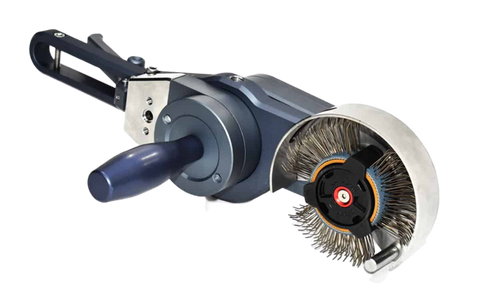Preparing a metal substrate underwater can be challenging due to the presence of water, which can interfere with traditional surface preparation methods like cleaning, drying, and applying coatings. However, there are specialized techniques and equipment that can be used for underwater metal substrate preparation. Here's a general outline of the process:
- 1. Surface Cleaning: Before any surface treatment, it's important to clean the metal substrate to remove contaminants such as dirt, oil, grease, and marine growth. Underwater cleaning methods may include using high-pressure water jets, underwater brushes, or abrasive blasting techniques specifically designed for use underwater. These methods help to ensure good adhesion of subsequent coatings.
-

Cavitation gun to remove debris, biofilm and corrosion deposits
- 2. Surface Roughening: To promote adhesion, it may be necessary to roughen the metal surface. Underwater abrasive blasting with appropriate abrasives can be used to achieve the desired surface profile. The blasting process should be carefully controlled to avoid damaging the substrate or causing excessive turbulence in the water.

|
|
- 3. Surface Protection: Once the surface is cleaned and roughened, it's essential to protect it from corrosion until further treatment can be applied. This may involve the temporary application of corrosion inhibitors or underwater-compatible primers to prevent the metal from corroding while underwater.

|
Allter ViscoRite, visco elastic coating systems that can be applied under water. |
-
Application of Coatings: After surface preparation, coatings can be applied to the metal substrate to provide protection against corrosion and other environmental factors. Specialized underwater coatings are available for this purpose, and they can be applied using techniques such as underwater spraying, brushing, or diving. These coatings should be selected based on the specific underwater conditions and the requirements of the application.
-
Quality Control: It's important to ensure that the surface preparation and coating application meet the required standards and specifications. Quality control measures may include visual inspection, adhesion testing, and monitoring of coating thickness.
-
Maintenance: Regular maintenance and inspection of the underwater coating system are essential to ensure its long-term performance. Periodic inspections should be carried out to detect any signs of damage, corrosion, or coating degradation, and appropriate repairs or recoating should be performed as needed.
Overall, preparing a metal substrate underwater requires specialized equipment, techniques, and coatings designed specifically for underwater applications.

|
Bristle blaster subsea Quattro |
By following proper procedures and guidelines, it's possible to achieve effective corrosion protection and prolong the service life of metal structures submerged in water.
